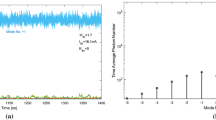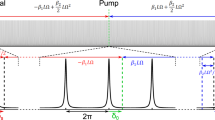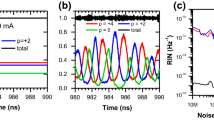Abstract
The nonlinearity of a frequency-ramped single-mode laser source to be used in optical heterodyne interferometry has been investigated. The analysis is based on mode-hopping due to variation in injection current, temperature and mismatch reflections.
Similar content being viewed by others
References
Ribun Onodera, et al., “Effect of Laser-Diode Power Change on Optical Heterodyne Interferometry,”IEEE Journ. of Light. Tech., Vol. 13, No. 4, pp. 675–681, April 1995.
G. Economou, et al., “Limitations and Noise in Interferometric Systems Using Frequency Ramped Single-mode Diode Lasers,”IEEE Journ. of Light. Tech., Vol LT-4, pp. 1601–1608, 1986.
B. Rawat, et al., “Effect of Laser Source Linearity on Optical Heterodyne Interferometry,”International Journal of Infrared and Millimeter Waves, Vol. 17, No. 3, pp. 507–526, March 1996.
Y. Ishii, “Recent Developments in Laser Diode Interferometry,”Opt. Lasers Eng., Vol. 14, pp. 293–309, 1991.
D.A. Jackson, et al., “Pseudo-heterodyne Detection Scheme for Optical Interferometers,”Electron. Letters, Vol. 18, pp. 1081–1083, 1982.
M. Imai, et al., “Optical Heterodyne Displacement Measurement Using a Frequency Ramped Laser Diode,”Optical Communications, Vol. 78, pp. 113–117, 1990.
D. Uttam, et al., “Precision Time Domain Reflectometry in Optical Fiber Systems Using a Frequency Modulated Continuous Wave Ranging Technique,”IEEE Journ. of Light. Tech., Vol. LT-3, pp. 971–977, 1985.
Mazin R. Alalusi, et al., “Effects of Nonlinear Gain on Mode-hopping in Semiconductor Laser Diodes,”IEEE Journ. of Quantum Electron., vol. 31, p. 1181–1192, 1995.
M. Nakamura, et al., “Longitudinal Mode Behavior of Mode Stabilized AlxGaI-xAs Injection Lasers,”Journ. of App. Phys., Vol. 49, pp. 4644–4648, Sept. 1978.
H. Kawamishi, et al., “Gain Suppression in GaAs/AlGaAs TJS Lasers,”IEEE J. Quantum Electron, Vol. QE-17, pp. 823–824, June 1981.
G.R. Gray, et al., “Bistability and Mode Hopping in a Semiconductor Laser,”J. Opt. Soc. Amer. B., Vol. 8, pp. 632–638, Mar. 1991.
K. Pettermann, et al., “Laser Diode Modulation and Noise,” Boston, MA: Kluwer Academic, 1991.
H. Ishikawa, et al., “Longitudinal Mode Behavior of Transverse Mode Stabilized InGaAsP/InP Double Heterostructure Lasers,”App. Phys. Letters., Vol. 38, pp. 962–964, June 1981.
J. Manning, et al., “Strong Influence of Nonlinear Gain on Spectral and Dynamic Characteristics of InGaAsP Lasers,”Electron. Lett., Vol. 12, pp. 496–497, May 1985.
R.F. Kazarinov, et al., “Longitudinal Mode Self Stabilization in Semiconductor Lasers,”Journ. Appl. Phys., Vol 53, pp. 4631–4644, July 1982.
B.N. Gomatam, et al., “Theory of Hot Carrier Effects on Nonlinear Gain in GaAs-GaAlAa Lasers and Amplifiers,”IEEE J. Quantum Electron., Vol. 26, pp. 1689–1704, Oct. 1990.
N. Ogasawara, et al., “Longitudinal Mode Competition and Asymmetric Gain Saturation in Semiconductor Injection Lasers - II Theory,”Jpn. J. Appl. Phys., vol. 27, pp. 615–626, 1988.
M. Yamada, et al., “A Condition of single Longitudinal Mode Operation in Injection Lasers with Index Guiding Structure,”IEEE J. Quantum Electron., Vol. QE-15, pp. 743–749, Aug. 1979.
R.F. Kazarinov, et al., “Longitudinal Mode Self Stabilization in semiconductor Lasers,”Journ. Appl. Phys., Vol. 53, pp. 4631–4644, July 1982.
P. Brosson, et al., “Optical Coupling of Two Injection Lasers: A New Experimental Approach to Study the Gain Broadening Mechanism,”IEEE J. Quantum Electron., Vol. QE-14, pp. 727–736, July 1982.
W.E. Lamb, Jr., “Theory of an Optical Maser,”Phys. Rev., Vol. 134, pp. A1429-A1450, June 1964.
G.P. Agrawal, “Gain Nonlinearities in Semiconductor Lasers: Theory and application to Distributed Feedback Lasers,”IEEE J. Quantum Electron, Vol. QE-23, pp. 860–868, June 1987.
T.P. Lee et al., “Short Cavity InGaAsP Injection Lasers: Dependence of Mode Spectra and Single-longitudinal Mode Power on Cavity Length,”IEEE J. Quantum Electron. Vol. QE-18, pp. 1101–1113, July 1982.
Author information
Authors and Affiliations
Rights and permissions
About this article
Cite this article
Pillers, R.B., Rawat, B.S. Analysis of laser source nonlinearity due to longitudinal mode-hopping. Int J Infrared Milli Waves 17, 1809–1820 (1996). https://doi.org/10.1007/BF02069456
Received:
Issue Date:
DOI: https://doi.org/10.1007/BF02069456




